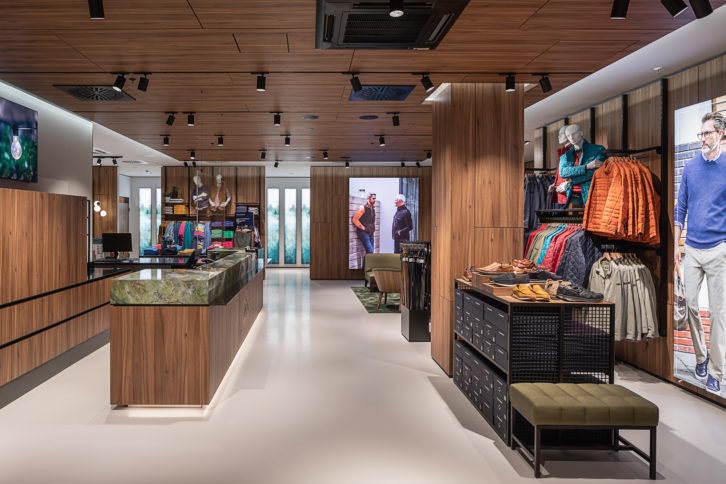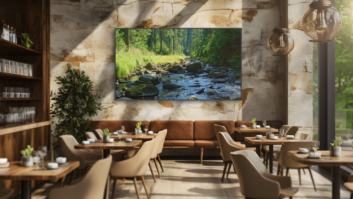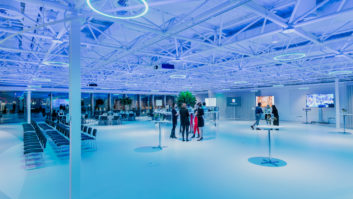The sense that retail is approaching a profound shift has been gathering momentum for several years now. Online sales were already rising steadily before the pandemic, so it’s not surprising that this trend accelerated further during lockdown when physical stores were shuttered for extended periods.
By November 2021, with the pandemic beginning to recede again (albeit variably), there was discussion of a hybrid retail trend. But in a time of supply uncertainty and economic downturn as a result of Covid, the war in Ukraine, rental increases and rising fuel prices, unpredictability is likely to remain a determining factor across retail for the foreseeable future. In many countries, these factors are making it difficult for retailers to define a long-term outlook in the physical ‘realm’.
 The statistics do not make for cheering reading; for example, a PwC report published in February 2022 and focused on the UK, found that there was a net decline of 10,059 physical chain store branches in 2021. The rate of closures has reduced a little, but the re-siting of existing stores accounts for many ‘openings’ – plus, it is not clear yet what impact the end of pandemic-era government support for retail will have long-term.
The statistics do not make for cheering reading; for example, a PwC report published in February 2022 and focused on the UK, found that there was a net decline of 10,059 physical chain store branches in 2021. The rate of closures has reduced a little, but the re-siting of existing stores accounts for many ‘openings’ – plus, it is not clear yet what impact the end of pandemic-era government support for retail will have long-term.
MORE RESILIENT
With retail park outlets shown to be “more resilient” to closure, it’s inevitable that there is again much debate of how to ‘reinvent’ the high street. More multi-tenant stores is one option; there is also talk of new community-oriented formats – such as smaller but more frequent markets – that could occupy some of the larger spaces. More generally, there is an awareness that a greater embracing of hybrid retail could be the key to unlocking a more permanent future for the high street.
There is no shortage of definitions of what constitutes a hybrid retail business, but one provided by EPOS Now is pleasingly concise: “a retail establishment that mixes traditional physical with e-commerce”. Far from being a source of trepidation, the hybrid model means that “brands can offer customers a fully-rounded shopping experience”.
LESS PHYSICAL
It seems beyond doubt that there will continue to be fewer physical stores in future. But is it possible that, among those that remain, there will be great opportunities for AV companies to help create more immersive, sensorily-impressive retail experiences and enable a closer relationship between the virtual and non-virtual retail worlds? After speaking to a leading trade association and a trio of suppliers whose business is largely in visual displays, the answer seems to be a resounding ‘yes’.
Sean Wargo, senior director of market intelligence at AV trade association AVIXA, comments: “Differentiation between physical storefront and online shopping has been a challenge for traditional retailers for a couple of decades now. This reached a tipping point during the pandemic when shoppers shifted even more online. Now that shoppers are more willing to come back, retailers are seeking more ways to attract them into their stores. AV offers a number of ways for the retailer to do so by increasing the level of engagement offered by the store” – using technologies including digital signage, larger interactive displays for customer browsing, and wayfinding displays in shopping malls.
 Nils Karsten – business segment lead for retail at Sharp NEC Display Solutions Europe GmbH – observes that recent changes in consumer behaviour have “also triggered a re-evaluation by retailers of the methods by which they plan and equip their stores.” The result is couple of primary questions, namely: “How to make the retail environment as customer friendly and exciting as possible? What are the reasons for a customer to leave the house, the sofa, the digital world and enter the physical store?”
Nils Karsten – business segment lead for retail at Sharp NEC Display Solutions Europe GmbH – observes that recent changes in consumer behaviour have “also triggered a re-evaluation by retailers of the methods by which they plan and equip their stores.” The result is couple of primary questions, namely: “How to make the retail environment as customer friendly and exciting as possible? What are the reasons for a customer to leave the house, the sofa, the digital world and enter the physical store?”
The merging of the different domains, indicates Karsten, will be crucial in ensuring people make that journey: “The more a brick-and-mortar store is able to blend the different worlds – ‘home-feel’, online offerings, the digital domain, but also the physical touch and maybe food – into one, and then add the benefit of experiencing these offerings right away, the more customers are willing to leave the comfort of home.”
FULL SOLUTION
For Sharp NEC, this development further underlines the need to approach the market as a “full solution” provider that can “support the blend of those worlds smoothly and effectively. Digital signage is done well when it has the wow-factor, yet seamlessly integrates in the store without taking the attention away from the items the retailer wishes to sell.” Hence a continued emphasis on working with “many alliance partners to offer a wide range of solutions”.
One major area of activity is integration with content management systems (CMS), which can be installed directly from the pre-installed Pi SoC Mediaplayer embedded inside our displays. From these CMS partners, and other partners that are featured, many social media platforms – such as LinkedIn, Instagram, Facebook and Twitter – are already integrated so content can be run on the NEC display, “nicely designed and ready to be used”.
There is no doubt that video is a cornerstone of many retailers’ renovations – bringing these various elements together and allowing store and brand presentation to be enhanced. Karsten notes: “Video-walls created from direct view LED are becoming more and more prevalent, as [this technology] morphs large surfaces into the corporate identity of the brand. This sends a strong message to your customers when entering the store and helps to differentiate from others. dvLED has become more affordable over the last few years, even in smaller pixel pitch sizes, making them real alternatives to LCD displays. Our new dvLED bundles of 120” size displays are great examples for that development, giving stunning picture quality while being extremely reliable and long lasting.” As well as different screen technology types, Karsten also points to Sharp NEC customers’ access to advanced technologies such as 8K, as well as “a roadmap to the new age of 5G, IoT and AI.”
SUPPLY SHORTAGES
Universal supply chain and component shortages notwithstanding, there is plenty of reason for optimism. “Product availability has impacted the market over the last year, but the outlook is encouraging with a predicted strong growth in digital and retail signage. The global digital signage market size is expected to reach USD 35.94 billion by 2026, a growth rate of 7.8%, according to Globe Newswire,” says Karsten.
 Henrik Hansen – business development manager at Samsung – also points to increasingly precise usage of digital displays, including to “engage your audience [with] dynamic content fit for a specific campaign and audience.” Additionally, he notes the rise in ‘social displays’ in retail, where feeds from social media sites are integrated into the digital screens in the store, enhancing the customer journey and interacting with the shoppers. For example, we have seen our displays used for retail solutions offering a recycling option in store; when you bring back a used garment for recycling, the screen provides a voucher and a QR code that allow you to instantly post on social media that you have taken a “green decision” (for yourself and the retailer).”
Henrik Hansen – business development manager at Samsung – also points to increasingly precise usage of digital displays, including to “engage your audience [with] dynamic content fit for a specific campaign and audience.” Additionally, he notes the rise in ‘social displays’ in retail, where feeds from social media sites are integrated into the digital screens in the store, enhancing the customer journey and interacting with the shoppers. For example, we have seen our displays used for retail solutions offering a recycling option in store; when you bring back a used garment for recycling, the screen provides a voucher and a QR code that allow you to instantly post on social media that you have taken a “green decision” (for yourself and the retailer).”
More generally, displays and other AV equipment will increasingly be in the service of creating memorable experiences, brand storytelling, and inspiring shoppers. “The digital solutions will be centred around providing this,” says Hansen. “There will be a focus on selling products that can be customised by the individual, and for the individual; the digital screens with interactive content can aid [the gaining of insight] into shoppers’ needs. [Plus] retail will continue to focus on omnichannel – in the sense of providing a seamless integration between offline and online, simply as future shoppers don’t distinguish between offline and online.”
RAPID REQUESTS
With a “rapidly increasing number of requests since the beginning of 2022” and a keen focus on driving footfall, Samsung has been providing everything from high brightness displays for front windows, to self-service-oriented touch displays such as the Samsung Kiosk Solution. Retail – like other sectors – is also picking up on the benefits of cloud-based platforms, including Samsung’s MagicINFO Cloud management system: “It [allows] retailers to control their content from one central location, and even offers integration into existing systems to display automated content based on stock levels, or other triggers. MagicINFO Cloud provides a full suite enabling the users to manage, schedule and distribute content on multiple displays, for multiple tenants in the facility.”
A joint response from Sony Professional Displays & Solutions –Jatin Bhatt (head of business development Europe) and Yoichiro Hotta (head of pan-EU B2B BRAVIA and LED marketing) – echoes the above sentiments about the “combination of offline and online” occurring in retail stores for some time now: “Customers still want to go to a store to see a physical product, to trial it, to talk to sales reps and finalise their decisions, even though they’ve researched online beforehand. It’s the experience they crave.”
To this end, they observe a shift towards retailers using AV to create an “interactive and immersive experience through gamification and personalisation” that strengthens the connection between brand and customer. “Retailers who aren’t solidifying their customer experience will struggle to retain clients, especially if they are in a retail segment that has heavy competition, eg. groceries and fast-fashion,” add Bhatt and Hotta.
RETAIL RESONATES
Products including 4K pro displays are continuing to resonate with retailers. “Digital signage is a big part of why AV is being used in retail and is essential in connecting online to offline to give customers a seamless journey. Our BRAVIA 4K Professional Displays help retailers bring their spectacular content to life in-store with supreme picture quality and peak brightness to deliver outstandingly bright, clear images in all areas of a retail space,” they say, adding that these displays can be used for a wide range of digital signage, smart wayfinding, advertising and interactive applications.
 The manufacturer is also monitoring another trend towards using some retail spaces more flexibly, including for office applications: “With many companies moving from central offices to regional offices, and in some cases no offices at all, we are seeing the retail store being a place for local employees to have a place to work as well (non-customer facing). An example of this is retail banking. With central offices encouraging remote working, staff can go into their local branch and hot desk too. Our corporate TEOS workplace solution offers room/desk/car parking booking and meeting room screens, as well as screens for customer facing signage.”
The manufacturer is also monitoring another trend towards using some retail spaces more flexibly, including for office applications: “With many companies moving from central offices to regional offices, and in some cases no offices at all, we are seeing the retail store being a place for local employees to have a place to work as well (non-customer facing). An example of this is retail banking. With central offices encouraging remote working, staff can go into their local branch and hot desk too. Our corporate TEOS workplace solution offers room/desk/car parking booking and meeting room screens, as well as screens for customer facing signage.”
DIGITAL CANVASES
Long-term, we can expect larger digital canvases and complex projection techniques to see ever-wider deployment. Bhatt and Hotta note: “We are seeing professional projectors being used more in retail as the creative aspect of being able to edge blend, pixel map, project onto a 3D wall or object, and connect the physical with the digital is key to enhancing customer experiences in-store. For bigger and more breath-taking displays, our Crystal LED display series brings the power of images to stores unlike no other, and was recently installed in cosmetics brand Shiseido’s Global Innovation Centre [in Yokohama, Japan]. Alongside these we have direct-view Micro-LED technology that can be built up to any size, and due to no bezels, it can be integrated into the architecture of a building.”
AVIXA’s Wargo points to several other technology areas where we are likely to see innovation from retailers, including immersive audio: “The idea here is to customise the audio experience to the shopper so that relevant content is delivered to them using beam-forming technology. Or perhaps delivered to the mobile device through an augmented reality solution. Installed speakers certainly are a clearer pro-AV opportunity here along with digital signage, lighting, projection mapping, and a host of other technologies. Fortunately, brands will approach the needs in different [ways], creating opportunity across the board, whether for AR U/X developers or integrated solutions providers. This is the beauty of the technology market going forward – it now plays an intrinsic part in the delivery of experiences to the end customer.”
 Meanwhile, the implications of increased interactivity and network access were the subject of a recent feature in Installation, and of course retail is not immune to these challenges either. Suggesting that vendors are highly active on these issues, there are references across the board to the importance of complying with data protection measures, including GDPR, and security standards. For example, Sharp NEC’s Karsten remarks: “Covering all the security standards such as 802.1X [IEEE authentication standard] with our computing hardware is critical to win projects, and ensure that clients and integrators won’t face any security issues. Both the Raspberry Pi as well as all our Intel®SDM related computing hardware integrated within our displays meet these security requirements. Our proprietary NaviSet Administrator tool for the remote management and control of displays on a network is also proven to meet all security standards.”
Meanwhile, the implications of increased interactivity and network access were the subject of a recent feature in Installation, and of course retail is not immune to these challenges either. Suggesting that vendors are highly active on these issues, there are references across the board to the importance of complying with data protection measures, including GDPR, and security standards. For example, Sharp NEC’s Karsten remarks: “Covering all the security standards such as 802.1X [IEEE authentication standard] with our computing hardware is critical to win projects, and ensure that clients and integrators won’t face any security issues. Both the Raspberry Pi as well as all our Intel®SDM related computing hardware integrated within our displays meet these security requirements. Our proprietary NaviSet Administrator tool for the remote management and control of displays on a network is also proven to meet all security standards.”
CYBER SECURITY
As the cyber-security environment continues to become more challenging, it is likely that compliance needs will grow more demanding – and rightly so. Otherwise, it is clear that, after a long period of difficulty for this sector, there is reason to look forward with excitement. Last word to Wargo, who cites “strong recovery” in retail and hospitality-related AV: “Our quarterly indicator of demand for pro AV products and services shows this recovery as both markets top the list of those planning to increase their spending on capital improvement projects year over year, thereby benefiting pro AV as well. [To this end] AVIXA expects AV spending by retail and hospitality buyers to increase by approximately 11% this year.”







